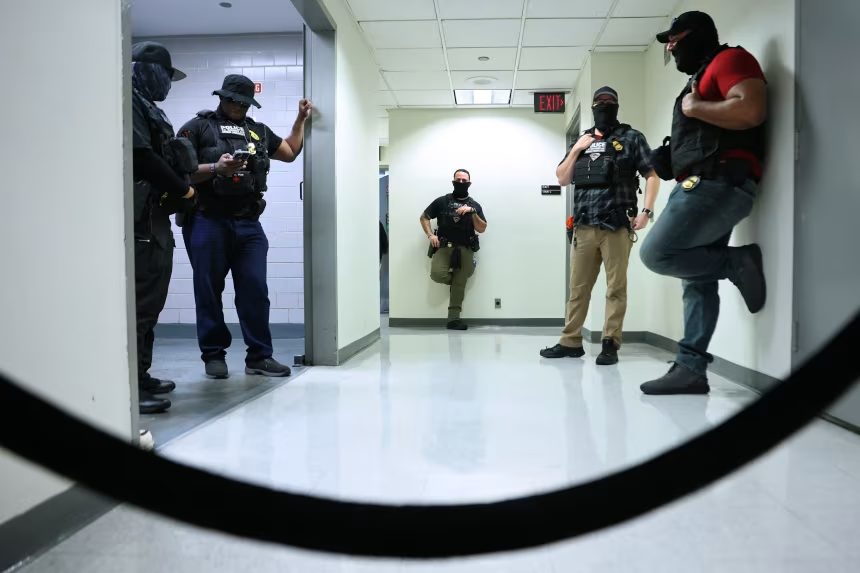Washington, D.C. — The Trump administration is preparing to overhaul leadership within U.S. Immigration and Customs Enforcement (ICE) as frustration grows over the agency’s failure to meet internal arrest targets, according to multiple officials familiar with the ongoing planning. The move marks one of the most significant internal shifts since President Donald Trump returned to office, reflecting renewed pressure to fulfill his promise of mass interior immigration enforcement.
Pressure from the Top
Since the start of this year, the White House has made immigration enforcement a top domestic priority. Senior advisers reportedly set a goal of roughly 3,000 daily immigration arrests, a number far above what ICE has historically achieved. Despite ramped-up field operations and expanded coordination with Border Patrol, officials say the agency has consistently fallen short.
President Trump and his top aides have privately expressed disappointment that ICE has not met expectations despite broad political and legal authority. “This administration expects results, not excuses,” one senior official said, describing the president’s mood as “impatient and focused.”
Plans for Leadership Changes
To close the gap between goals and outcomes, administration officials are now finalizing a plan to reassign or replace leadership across several ICE field offices. The changes could affect more than a dozen regional directors nationwide, particularly those who have failed to reach their operational benchmarks.
While DHS spokespeople have not confirmed specific personnel moves, the plan is said to involve introducing new leadership drawn from U.S. Border Patrol and other enforcement arms under the Department of Homeland Security (DHS). The idea, according to internal discussions, is to inject a more aggressive, hands-on approach to field operations.
“Results will drive leadership,” a senior DHS official said. “This is about accountability and performance.”
Border Patrol’s Expanding Role
In recent months, the Department of Homeland Security has increasingly relied on Border Patrol agents to assist ICE in executing arrests across the country — even in cities far from the border. Over 1,500 agents have been temporarily reassigned to interior operations, conducting raids, monitoring workplaces, and tracking down individuals with pending deportation orders.
One high-profile figure in this effort has been Gregory Bovino, a longtime Border Patrol official who has overseen enforcement campaigns in major Democratic-led cities, including Chicago and Los Angeles. His success, according to administration sources, has turned him into a model for how the White House envisions a more forceful immigration crackdown.
Why the Numbers Matter
Behind the administration’s urgency lies a broader political calculation. President Trump’s campaign rhetoric centered heavily on restoring “law and order” and dramatically reducing undocumented populations within the United States. Meeting the 3,000-arrest target is seen not just as an operational benchmark but as a symbolic victory— proof that his administration is delivering where previous governments hesitated.
Yet meeting that goal has proven more complicated than anticipated. ICE, which employs around 5,500 enforcement officers nationwide, faces logistical and resource limitations. Many field offices are understaffed, and detention capacity remains strained despite emergency funding requests. Additionally, legal backlogs in immigration courts mean that arrests often translate into months—or even years—of processing before removal.
Internal Tensions and Morale
Inside ICE, the renewed push has created a mix of pressure and uncertainty. Career officers describe a tense environment, with regional directors being evaluated almost daily on arrest metrics. Some worry that the focus on numbers could shift attention away from complex criminal cases and encourage “low-hanging fruit” arrests of individuals with no prior offenses.
“There’s a fine line between enforcing the law and chasing statistics,” said one field supervisor, speaking on condition of anonymity. “We’re law enforcement officers, not political scorekeepers.”
Still, supporters of the shake-up argue that performance-based accountability is long overdue. They contend that some ICE field offices have become “complacent” over the past few years and need new leadership to meet the president’s objectives.
DHS Response
In a brief statement, DHS spokesperson Tricia McLaughlin said the administration remains “laser-focused on removing violent criminal aliens and securing our communities.” She declined to discuss any pending personnel changes but emphasized that the administration would “not tolerate underperformance when national security and the rule of law are at stake.”
Officials say that once the shake-up is finalized, replacements will be announced swiftly—possibly before the end of November. Some current ICE leaders are expected to be reassigned rather than dismissed outright, in an effort to avoid public disruption.
The Broader Impact
The leadership changes come as immigration continues to dominate national debate. Supporters of the administration’s hardline approach argue that stricter enforcement is essential to deter unlawful crossings and maintain credibility in the system. Critics, however, warn that expanding interior raids risks fueling fear in immigrant communities and may strain relations between federal agents and local law enforcement.
Civil rights advocates are also raising concerns about the growing role of Border Patrol in domestic operations, traditionally overseen by ICE. They warn that the blending of missions could blur oversight lines and increase the risk of overreach.
Looking Ahead
For now, ICE is operating under intense scrutiny from both the White House and the public. Officials familiar with the situation say the next few weeks will determine whether the agency’s internal restructuring translates into measurable results — or whether it deepens internal divisions.
Either way, the Trump administration appears determined to prove that its enforcement agenda will not stall. With a renewed focus on speed, volume, and accountability, the coming months could mark a new, more aggressive era for immigration enforcement inside the United States.

